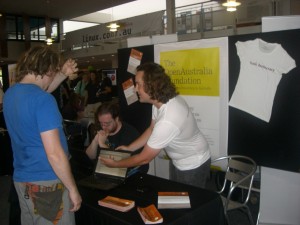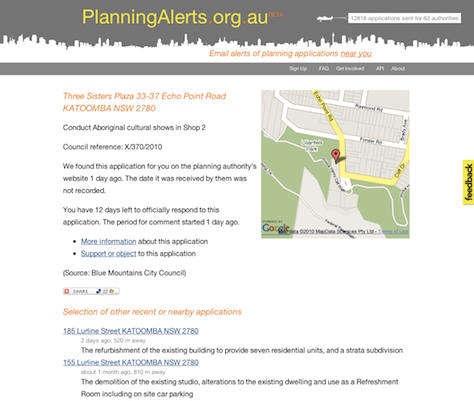On Saturday the 27th of November 2010 Victorians are going to the polls with the very big job of electing their next state government. That is a little over a month away.
Two weeks ago, a few of us who had worked on ElectionLeaflets.org.au during the Federal election got together to talk about what we should do next with the site.
With the upcoming Victorian election it seemed clear. Let’s make ElectionLeaflets work for the Victorian election as well.
We set today as our deadline for launching it.
Well, to cut a long story short, the disappointing thing is that we haven’t made it. We won’t be launching that site today.
There are a few reasons for this.
Firstly, remember that despite ElectionLeaflets being run by a charity, don’t assume that anyone is being paid to work on this. Quite the contrary, all the work that has gone into the site, setting it up, designing it, publicising it and talking to the media about it has all been done by unpaid volunteers.
We were hoping that adding support for multiple elections to ElectionLeaflets would be relatively straightforward, as the original developers had already thought about this from the beginning. However, it turned out to not be completely trivial. To make the required changes would need a bit of work – probably a few more full days effort.
We’re pretty good at getting things done on the smell of an oily rag and very little time but in this case with only one weekend, a few short evenings, and only two developers available, we simply ran out of time.
Despite the widespread media coverage and praise of ElectionLeaflets during the Federal election campaign, nobody came forward to say “Here’s a donation to support the running of the site and to ensure that it can be around for future elections.”
If that had happened we could have sponsored a developer to focus on this full time. It wouldn’t have taken much.
Donations for the site would also help pay for the PO Box that we rent to collect posted leaflets and help pay for the hosting of the leaflet images on Amazon’s S3 service.
Secondly, beyond the original core team of a dozen or so volunteers, we haven’t had many other people approach us offering their help to make this happen.
This is where you come in – our next goal is to cover the New South Wales state election in March 2011. The last couple of weeks has reminded us all that projects like this don’t build themselves and we need people that are as passionate as we are about keeping our elections fair and honest.
You can help shape this exciting project, and feel good knowing you’ve made a difference to electioneering in Australia. You’ll also be supported by a talented and diverse group of volunteers that are keen to share their skills and experience.
So if you want to see ElectionLeaflets cover the next election you’re called to vote in, you can start by making a donation, telling your friends about ElectionLeaflets, asking us questions on the mailing list, checking the existing trouble tickets, or even downloading our open source code and diving straight in.
If you’re not sure how to get started, please let us know in the comments how we can better help you get involved.
Henare and Matthew
OpenAustralia Foundation volunteers
PS. Victorians can still send their physical leaflets to:
Riley & Ephemera Collection,
C/O Australian History & Literature Team Access and Information Division State Library of Victoria,
328 Swanston Street,
Melbourne VIC 3000 Australia
Donors should include their name and contact details if they would like an acknowledgment of their donation and they only accept hardcopy donations (not scanned copies, or photographs).






Wonderful new features for PlanningAlerts
Today, we’re happy to announce that we’ve added some wonderful new features to PlanningAlerts which are the start of something big.
Until now, the focus of PlanningAlerts has been squarely and clearly about notifying you of new development applications in your area. That notification happens via email.
We’ve added two new big features which allow you to easily explore development applications and comment on them.
Commenting
Finding out about a new development application in your neighbourhood should be the start of something. If it’s something that you agree with or disagree with the standard course of action is that you submit a comment on the development application to your local council.
Really, there should be a way for the community at large to discuss these issues without the local council having to act as an intermediary. Of course, this already happens on the Internet in the form of people writing blog posts, talking on Twitter and Facebook and numerous other avenues.
Wouldn’t it be great if you could see all those conversations in one place, alongside the development application itself? Then, the application page becomes a jumping off point to read what people think all over the place.
To begin with, this is what we’ve done: now whenever you tweet about a development application, and include a link to the PlanningAlerts page, it will be listed on our site:
We’re hoping this will spark discussion and make PlanningAlerts even more useful by allowing people to provide additional information about the development application.
One use of this could be taking a photo with your mobile phone (after find the location using our augmented reality mobile application, of course) and tweeting about it. The link will then show up on PlanningAlerts, allowing others to see what the new development looks like.
Give it a try and let us know what interesting uses you come up with by posting a comment.
Exploring
We’ve also changed the home page. You can now enter a street address and it will immediately show you recent development applications nearby. No need to wait on receiving your first email alert.
This is great for people who’ve never used the service before. They get a taste of what it does before they commit to entering their email address:
We hope you enjoy these new features and don’t forget you can help us improve them by posting a comment below, using the feedback button on PlanningAlerts or, even better, getting involved yourself.
Henare, Kat and Matthew